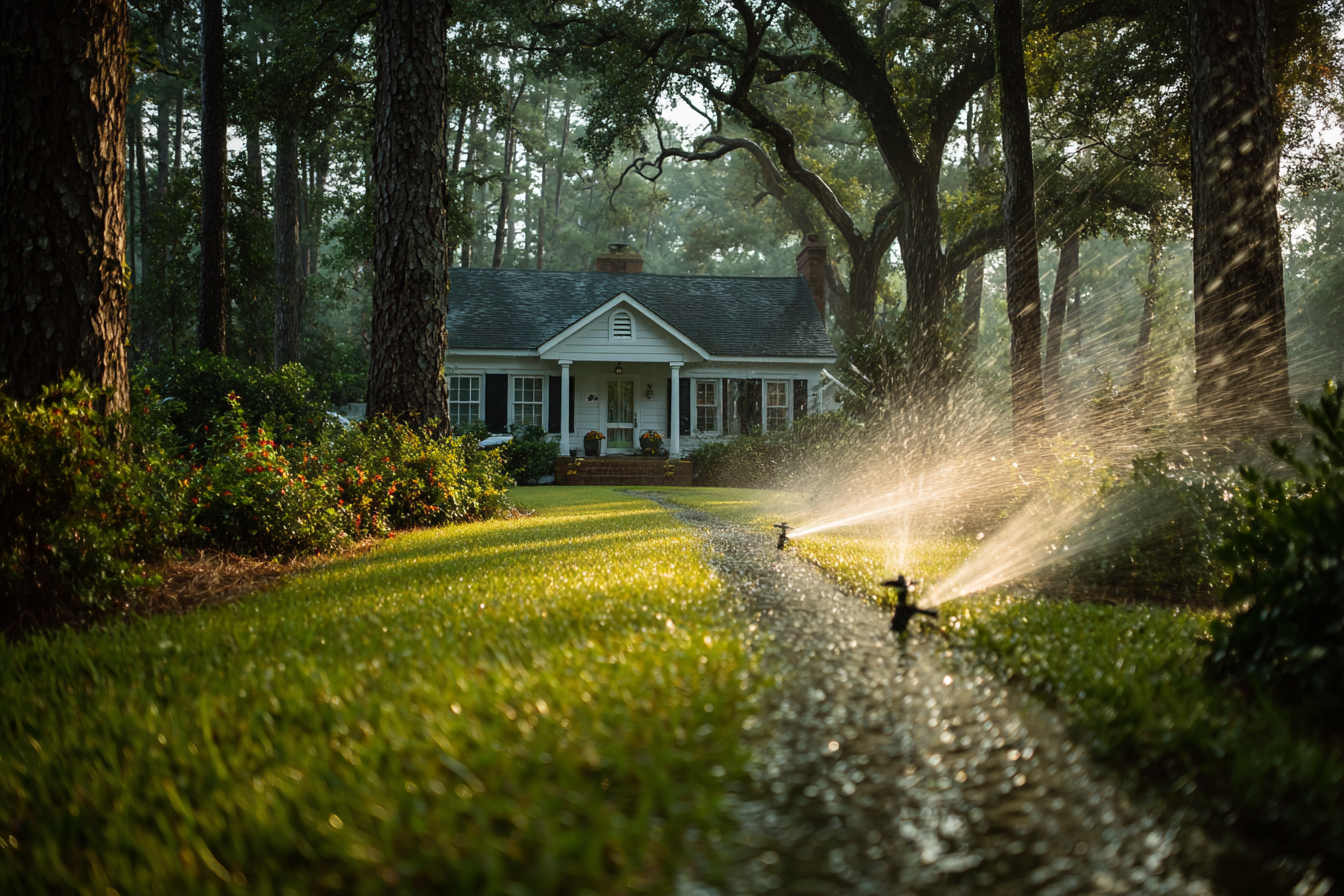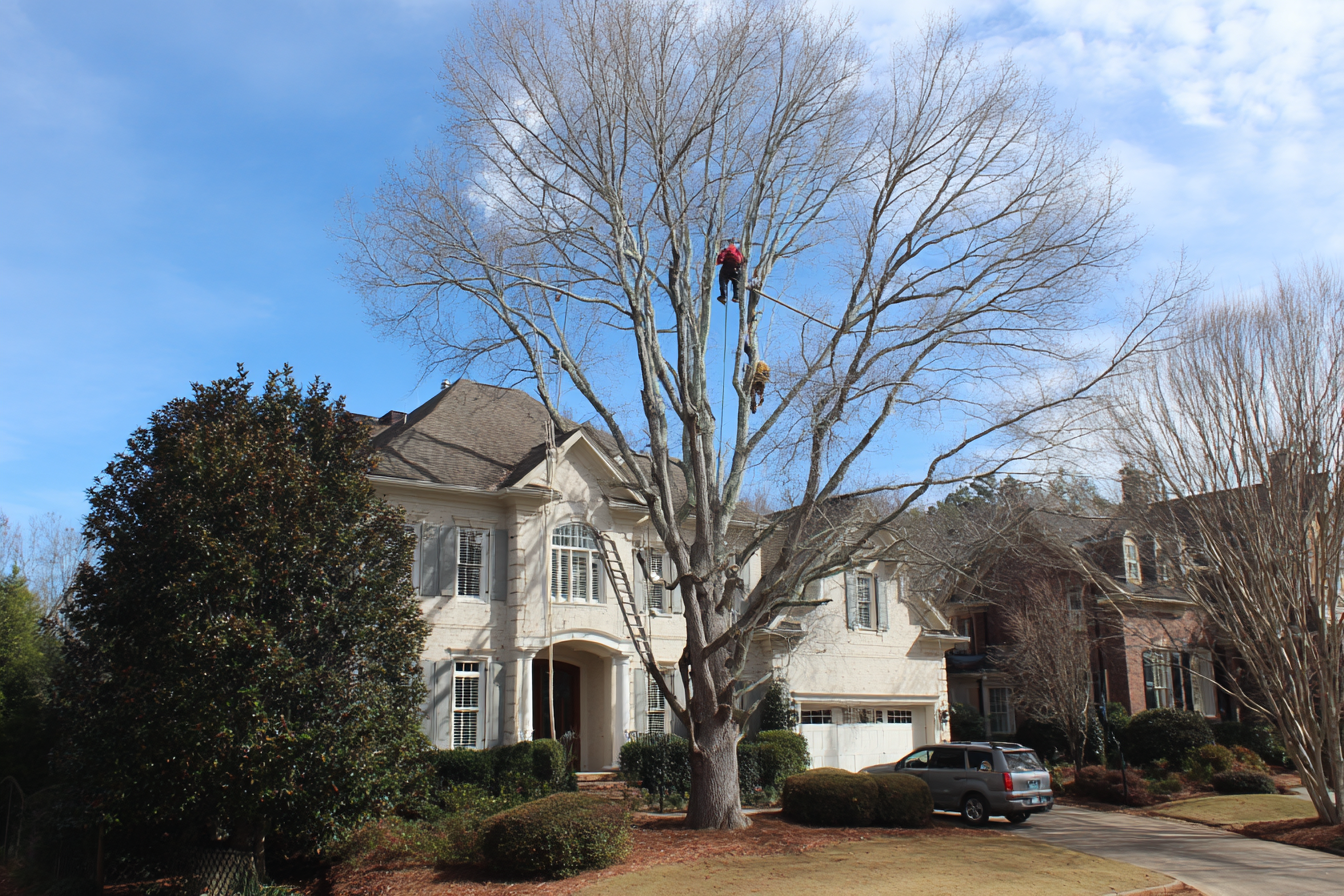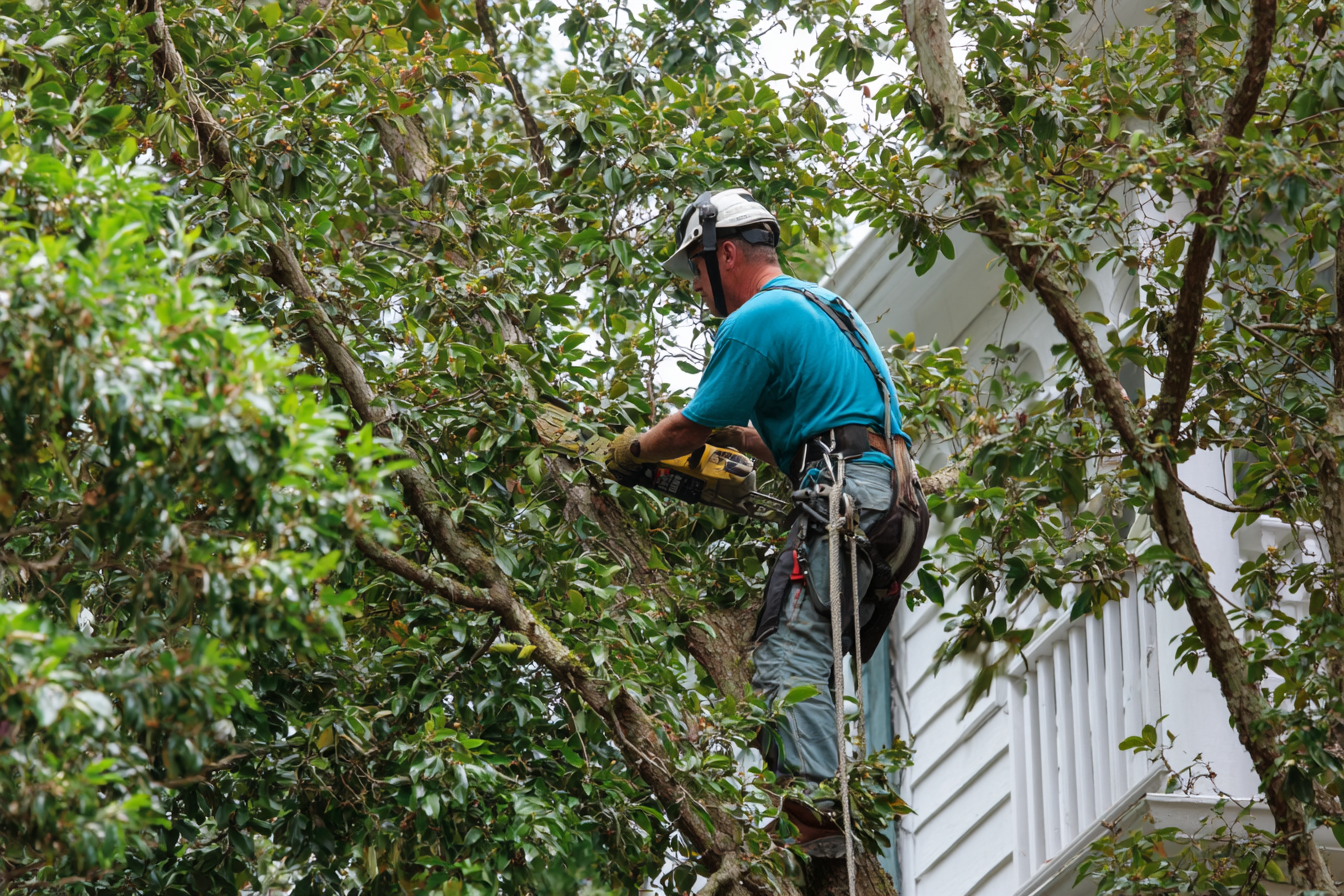
Georgia summers are legendary for their heat and humidity. While we may enjoy the long days and sunshine, this climate can be incredibly tough on our trees. High temperatures and limited rainfall place significant stress on your landscape, leading to wilting, disease, and even long-term decline. As homeowners, it's our responsibility to provide our trees with the care they need to thrive, not just survive. This means adopting smart, water-wise strategies to keep them hydrated and healthy when the temperatures soar.
The challenge lies in finding the right balance. Too little water, and your trees will suffer from drought stress. Too much water, and you risk root rot and other serious issues. The key is to understand the specific needs of your trees and learn how to water them effectively and efficiently. This comprehensive guide will walk you through the essential steps to conserve water while ensuring your trees remain a beautiful and valuable part of your property. We'll cover everything from proper watering techniques to the benefits of mulching and what signs to look for when your trees are in distress. By the end, you'll be an expert in protecting your leafy giants from the summer heat.
Understanding the Impact of Drought Stress on Trees
Just like any living organism, trees need water to live. Water moves up from the roots to the leaves, carrying essential nutrients and helping the tree cool itself through a process called transpiration. During a drought or heatwave, this process is disrupted. The tree can't get enough moisture from the soil, leading to a host of problems. Leaves may wilt, turn yellow, or even drop prematurely. This isn't just an aesthetic issue; it's a sign that the tree is struggling to perform basic life functions.
Prolonged drought stress can weaken a tree's immune system, making it more susceptible to pests and diseases. The tree may also lose its structural integrity, with branches becoming brittle and more likely to break in a storm. In the most severe cases, the lack of water can cause irreversible damage, leading to the tree's death. This is why being proactive with your watering strategy is so crucial. Don't wait for your trees to show signs of severe stress; implement a plan now to ensure they can weather the summer months. A healthy tree is a safe tree, and proper care is the best prevention.
The Art of Watering: Deep and Infrequent
When it comes to watering your trees, the common assumption is that more is always better. This isn't necessarily true. The goal is to encourage deep root growth, not to keep the surface of the soil constantly wet. Shallow watering, such as a light sprinkling with a hose every day, only encourages roots to grow near the surface. These shallow roots are the first to dry out, making the tree even more vulnerable during a heatwave.
The best approach is to water deeply and infrequently. This means applying enough water in a single session to penetrate the soil several inches down, where the tree's roots are. For established trees, this can mean giving them a thorough soaking once every one to two weeks, depending on rainfall. For newly planted trees (in the ground for less than three years), they need more frequent attention, typically 10-15 gallons of water two to three times per week if there is no rain.
- Soaker Hoses: These are an excellent tool for deep watering. Lay the hose in a spiral pattern around the base of the tree, starting a foot or so from the trunk and extending out to the drip line (the edge of the canopy). Run the water at a low trickle for 30-60 minutes to ensure deep saturation without runoff.
- Drip Systems: For a more automated approach, consider installing a drip irrigation system. These systems deliver water directly to the root zone at a slow, steady rate, minimizing waste from evaporation.
- The Bucket Method: A simple yet effective method is to use a 5-gallon bucket. Drill a few small holes in the bottom and place it near the base of the tree. Fill it with water and let it slowly drain into the soil. Repeat this process three times to deliver a total of 15 gallons.

Timing is Everything: When to Water
The time of day you water your trees can make a significant difference in how much water they actually absorb. Watering in the middle of a hot, sunny day is highly inefficient. A large percentage of the water will simply evaporate before it has a chance to reach the roots.
The best time to water is in the early morning or late evening. This allows the water to soak into the soil when temperatures are cooler and the sun's rays are less intense. Watering in the morning is generally preferred, as it helps prevent the growth of fungal diseases that thrive in moist, dark conditions overnight.
Another important rule to remember is to avoid watering the trunk of the tree directly. Keep water focused on the root zone, away from the base. Constantly wet bark can lead to fungal growth, rot, and other diseases that can compromise the tree's health.
The Power of Mulch: Nature's Protection
Mulch is one of the most effective and easiest ways to conserve water and protect your trees. A layer of organic mulch, such as pine straw, pine bark, or shredded hardwood, acts as a protective blanket for the soil.
Here's how mulch helps your trees survive the summer:
- Moisture Retention: Mulch slows down the evaporation of water from the soil, keeping the root zone moist for longer periods. This means you won't have to water as frequently.
- Weed Suppression: A good layer of mulch will suppress weeds, which compete with your tree for water and nutrients.
- Temperature Regulation: Mulch helps to insulate the soil, keeping the roots cooler during the summer and warmer in the winter. This is crucial for preventing heat stress on the root system.
- Improved Soil Health: As organic mulch decomposes, it enriches the soil with nutrients, improving its overall structure and ability to retain water.
When applying mulch, remember a few key rules. Create a donut-shaped ring around the base of the tree, keeping the mulch 3-5 inches deep. Be sure to pull the mulch away from the trunk, creating a space of several inches. This prevents moisture from building up against the bark, which can lead to rot and pest problems.
Recognizing the Signs of a Thirsty Tree
Being able to identify when your tree needs water is a critical skill for any Georgia homeowner. While the signs of drought stress can be subtle, they are often a clear cry for help.
Here are some of the most common indicators that your tree is thirsty:
- Wilting or Curling Leaves: Leaves may droop or curl inward to reduce their surface area, a natural defense mechanism against water loss.
- Yellowing or Browning: The leaves may turn a dull, off-color yellow or brown, often starting at the tips or edges. This is sometimes called "leaf scorch."
- Premature Leaf Drop: Your tree may begin to shed its leaves earlier than usual, particularly in late summer.
- Sparse Canopy: The overall canopy may appear thin or sparse, with fewer leaves than normal.
- Soil Check: The most reliable method is to check the soil itself. Use a trowel or a long screwdriver to dig a few inches down into the soil. If the soil is dry and crumbly, it's time to water. If it's cool and moist, your tree is likely fine.

Drought-Tolerant Trees for Georgia Landscapes
If you're looking to add new trees to your landscape, consider species that are naturally more tolerant of Georgia's heat and dry spells. While all new trees require consistent watering to become established, choosing the right species can significantly reduce your maintenance efforts in the long run.
Some excellent drought-tolerant and native Georgia tree options include:
- American Sycamore: A large, fast-growing shade tree that is native to the state.
- Northern Red Oak: A handsome and stately tree with deep roots.
- Tulip Poplar: Another fast-growing native that does well on slopes.
- Ginkgo Tree: Known for its fan-shaped leaves and resilience.
- Eastern Red Cedar: A conifer that thrives in dry areas along the East Coast.
- Hackberry: A "tough tree" that adapts well to a variety of soils.
- Muskogee Crape Myrtle: A popular choice for its beautiful flowers and heat tolerance.
Conclusion: A Little Effort Goes a Long Way
Caring for your trees during a hot Georgia summer doesn't have to be a full-time job. By implementing a few simple, strategic practices, like deep, infrequent watering, applying a protective layer of mulch, and paying attention to your tree's signals, you can make a huge difference in their health and longevity. These small efforts not only help you conserve water but also protect the significant investment your trees represent.
However, sometimes a tree's needs go beyond what a homeowner can provide. If you notice signs of severe stress, disease, or have concerns about a tree's stability, it's essential to call in the professionals.
Don't let the Georgia heat get the best of your trees. For expert advice and professional tree services, contact Georgia Pro Tree Services. Our team of certified arborists can help assess your trees' health, provide a comprehensive care plan, and ensure they are safe and beautiful for years to come. Contact us today for a free consultation!
FAQs On Tree Watering
Q1: How do I know if I'm overwatering my tree?
A1: Overwatering can be just as harmful as under-watering. Signs of an overwatered tree include new growth withering before it's fully grown, leaves turning a light green or yellow, and the soil around the tree being constantly soggy. To check the moisture level, dig a few inches down. If the soil is muddy or soaking wet, you're likely overwatering. Overwatering can lead to root rot, which starves the tree's roots of oxygen and can eventually kill the tree.
Q2: Should I fertilize my trees during a drought?
A2: No, you should avoid fertilizing your trees during a drought or a period of high heat. Fertilizers are chemical salts that can dehydrate the roots and cause further stress to an already struggling tree. The best time to fertilize is in the spring when new growth begins and the tree is actively taking up nutrients. If you have a healthy, established tree, it may only need to be fertilized every two to three years.
Q3: Can I water my tree with a sprinkler system?
A3: A sprinkler system designed for your lawn is generally not the best way to water a tree. The water from a sprinkler often gets consumed by the grass before it can penetrate deep enough to reach the tree's roots. It also encourages the growth of shallow roots, which are more vulnerable to drought. The most effective methods are those that deliver a slow, deep soaking directly to the root zone, such as soaker hoses or the bucket method.
Q4: How much water does a mature tree need in the summer?
A4: A good rule of thumb for a mature tree is to aim for about 1 inch of water per week, either from rainfall or supplemental watering. You can use a rain gauge to track natural precipitation. When watering, ensure the water penetrates 6-9 inches into the soil. A long, slow soaking is always better than a quick, light sprinkling. This can be achieved by running a soaker hose for 30-60 minutes around the tree's drip line.
Q5: What is the "drip line" and why is it important for watering?
A5: The drip line is the imaginary circle on the ground that corresponds to the outermost edge of a tree's branches. This is where most of a tree's "feeder roots" are located, which are responsible for absorbing water and nutrients. When watering, it's crucial to focus your efforts on this area, not just the base of the trunk. Watering the entire area from the trunk out to the drip line ensures that the water reaches the active root zone where it's needed most.

We're your local tree pros!
Georgia Pro Tree Services takes the highest quality of care when servicing your trees. Call us to find out how we can help you keep your yard in top shape.



